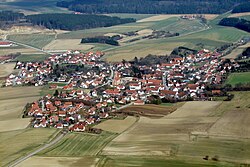
Bavaria, officially the Free State of Bavaria, is a landlocked state (Land) in the south-east of Germany. With an area of 70,550.19 square kilometres (27,239.58 sq mi), Bavaria is the largest German state by land area, comprising roughly a fifth of the total land area of Germany. With over 13 million inhabitants, it is second in population only to North Rhine-Westphalia, but due to its large size it is one of the least densely populated states. Bavaria's main cities are Munich, Nuremberg, and Augsburg.

Franconia is a region in Germany, characterised by its culture and language, and may be roughly associated with the areas in which the East Franconian dialect group, colloquially referred to as "Franconian", is spoken. There are several other Franconian dialects, but only the East Franconian ones are colloquially referred to as "Franconian".

Munich is the capital and most populous city of Bavaria. With a population of 1,558,395 inhabitants as of 31 July 2020, it is the third-largest city in Germany, after Berlin and Hamburg, and thus the largest which does not constitute its own state, as well as the 11th-largest city in the European Union. The city's metropolitan region is home to 6 million people.

Louis IV, called the Bavarian, of the house of Wittelsbach, was King of the Romans from 1314, King of Italy from 1327, and Holy Roman Emperor from 1328.
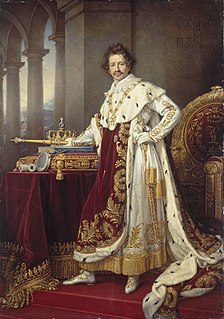
Ludwig I or Louis I was king of Bavaria from 1825 until the 1848 revolutions in the German states.

Upper Bavaria is one of the seven administrative districts of Bavaria, Germany.

Lower Bavaria is one of the seven administrative regions of Bavaria, Germany, located in the east of the state.

Maximilian II reigned as King of Bavaria between 1848 and 1864.

Franz Josef Strauss was a German politician. He was the long-time chairman of the Christian Social Union in Bavaria (CSU) from 1961 until 1988, member of the federal cabinet in different positions between 1953 and 1969 and minister-president of the state of Bavaria from 1978 until 1988. Strauss is also credited as a co-founder of European aerospace conglomerate Airbus.

Princess Ludovika of Bavaria was the sixth child of King Maximilian I Joseph of Bavaria and his second wife, Karoline of Baden, and the mother of Empress Elisabeth of Austria. She was born and died in Munich.

Landshut is a town in Bavaria in the south-east of Germany. Situated on the banks of the River Isar, Landshut is the capital of Lower Bavaria, one of the seven administrative regions of the Free State of Bavaria. It is also the seat of the surrounding district, and has a population of more than 70,000. Landshut is the largest city in Lower Bavaria, followed by Passau and Straubing, and Eastern Bavaria's second biggest city.

Ludwig III was the last king of Bavaria, reigning from 1913 to 1918. Initially he served in the Bavarian military as a lieutenant and going on to hold the rank of Oberleutnant during the Austro-Prussian War. He entered politics at the age of 18 becoming a member of the Bavarian Legislature and keen participant in politics, endorsing agricultural and voting reforms. Later in life he served as regent and de facto head of state from 1912 to 1913, ruling for his cousin, Otto. After the Bavarian parliament passed a law allowing him to do so, Ludwig deposed Otto and assumed the throne himself. He led Bavaria into World War I, and lost his throne along with the other rulers of the German states at the end of the war.
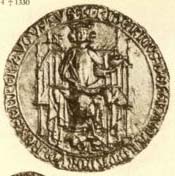
Frederick the Fair or the Handsome, from the House of Habsburg, was the duke of Austria and Styria from 1308 as well as the anti-king of Germany from 1314 until 1325 and then co-king until his death.

Rudolf I of Bavaria, called "the Stammerer", a member of the Wittelsbach dynasty, was Duke of Upper Bavaria and Count Palatine of the Rhine from 1294 until 1317.
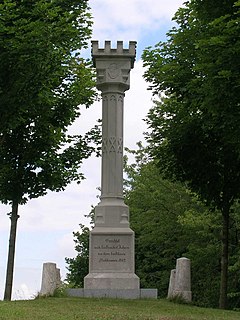
The Battle of Gammelsdorf took place in November 1313. The cause of the skirmish was the guardianship of the underage duke of Lower Bavaria. This was sought by both Duke Louis the Bavarian and Duke Frederick I of Austria. It circled around the question of who would execute tutelage over the minor children of the late Lower Bavarian Dukes, thus also commanding the tremendous economic power of that region. Their Upper Bavarian cousin, Duke Louis, the later Emperor Louis IV, the Bavarian, as agreements within the several branches of the Bavarian line of the House of Wittelsbach determined and as the burghers of the Lower Bavarian cities wanted to see it done, or Duke Frederick I of Austria, the Fair, also Louis' cousin, both having been raised and educated together in Vienna.

Hörgertshausen is a municipality in the district of Freising in Bavaria in Germany.

Live is the first live album by the American doom metal band Saint Vitus, recorded on November 10, 1989 at Germany's Circus Gammelsdorf. The album was released in 1990 on Hellhound Records. It was re-released by Southern Lord Records (SUNN43) in 2005. This was the final release to feature singer Scott "Wino" Weinrich until he rejoined Saint Vitus some years later, performing on their 2012 album Lillie: F-65.
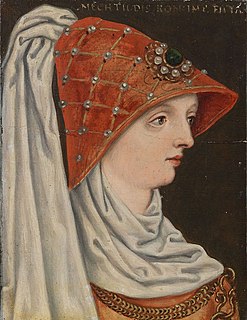
Matilda of Habsburg or Melchilde was, by marriage, a duchess of Bavaria. She was regent of Bavaria in the minority of her son, Rudolf I.

Ludwig II was King of Bavaria from 1864 until his death in 1886. He is sometimes called the Swan King or der Märchenkönig. He also held the titles of Count Palatine of the Rhine, Duke of Bavaria, Duke of Franconia, and Duke in Swabia.

The following outline is provided as an overview of and topical guide to Munich:
